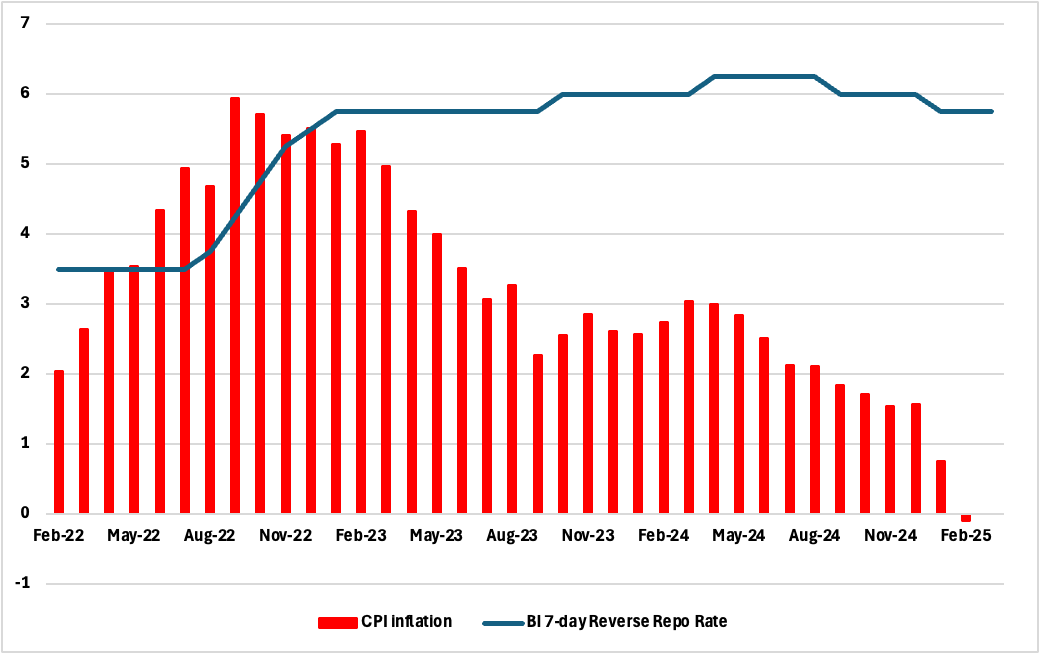Bank Indonesia Holds Steady Amid Fiscal Fears and Rupiah Rout
Bank Indonesia has decided to maintain its benchmark interest rate at 5.75%, reflecting a cautious stance amid the rupiah's depreciation and mixed economic signals. With the rupiah near five-year lows and influenced by external uncertainties, the central bank is balancing the need to support economic growth while ensuring currency stability. BI's future rate decisions will hinge on inflation trends and currency movements, as it carefully monitors a range of economic indicators to guide its monetary policy.
In its recent monetary policy meeting on March 19, Bank Indonesia (BI) elected to maintain the benchmark interest rate at 5.75%, reflecting a cautious approach amid a complex mix of domestic and global economic challenges. This decision aligns with our expectations, signalling the central bank's priority to balance supporting economic growth with maintaining currency stability.
Figure 1: Indonesia Policy Rate and CPI (%)

The decision to hold the rate steady comes as the Indonesian rupiah (IDR) trades near a five-year low of around 16,520 against the US dollar. This depreciation has been driven largely by external factors, including fluctuations in U.S. economic policies and broader global trade tensions, which have contributed to significant capital outflows. Governor Perry Warjiyo highlighted that while the fundamentals of Indonesia's economy might support a stronger rupiah, technical factors and market sentiment are currently weighing on the currency.
Governor Warjiyo emphasized the central bank's dual focus on controlling inflation and supporting the rupiah. He noted that any future adjustments to the interest rate would depend on a range of factors, including inflation trends and the rupiah's trajectory. This suggests that while the door remains open for rate cuts, such moves will be contingent on stabilising or improving economic indicators. It is worth noting that inflation has been subdued, with the consumer price index witnessing its first annual decline since 2000 in February, primarily due to temporary government measures such as reductions in electricity tariffs. With these measures set to expire, and given the central bank's inflation target range of 1.5% to 3.5%, BI is likely to continue monitoring price stability closely.
Meanwhile, BI continues to project GDP growth for 2025 in the range of 4.7% to 5.5%. This forecast accounts for ongoing challenges in surpassing the growth plateau of approximately 5%, a rate that Indonesia has struggled to exceed in recent years. Despite ambitious targets set by President Prabowo Subianto to lift growth to 8%, structural and external headwinds persist. Recent market reactions have been less favourable, evidenced by a sharp sell-off in Indonesian equities. Investor confidence has been dampened by concerns over fiscal sustainability and speculative rumours about changes in government leadership. Such sentiment underscores the fragile balance BI must manage between fostering investor confidence and maintaining economic fundamentals.
Looking ahead, BI's policy trajectory appears geared towards cautious monitoring, with potential rate adjustments likely later in the year, depending on economic conditions and external pressures. The central bank's ongoing vigilance in managing the interplay between growth, inflation, and currency stability will be crucial as it navigates through an uncertain global economic environment. We anticipates two 25bps rate cuts in H2-2025.